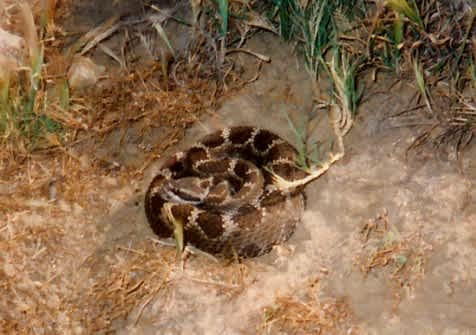Rattlesnake Wrangling: A Great Outdoors Pastime and Skill
Don Moyer 07.24.12

Some folks think that my hobby of catching live rattlers is a little weird, and who knows? Maybe they’re right. You’ve got admit though, catching rattlers is exciting. I have been catching rattlers on local ranches for about 30 years now and it has opened up thousands of acres of private ranchland to me. I have developed a symbiotic relationship with numerous local ranchers. All I have to do is catch a few rattlers from around the rancher’s homes, barns, and outbuildings, and I get access to explore and oftentimes to hunt or fish on thousands of acres. On the other side of the equation, the ranchers get rattlesnakes removed from areas where they, their kids, and ranch hands are most likely to get snakebit. If my snake wrangling only prevents one person from getting bitten, then I have succeeded in my goal.
This best time to catch rattlers is in the spring when the snakes are just coming out of hibernation, and the hills are green and studded with beautiful flowers. As the summer progresses, snakes are more active at night and early morning. By 10:00 am in midsummer rattlers are hunkered down in the shade. About 15 years ago, my snake catching partner, Don McGeein, my son, Bo, and I sallied forth to try our luck. Don is a darned good amateur taxidermist and does a great job mounting some of the snakes we catch. Rattlers also make great hatbands and belts. Our goal that weekend, though, was to obtain some rattlers for Bo’s Boy Scout Patrol. Let’s face it, Troop 414’s Sidewinder Patrol would not be complete without a real honest-to-goodness rattlesnake skin for the Patrol Banner.
Over the years Don, Bo, and I have worked out a pretty good system for catching the rattlers and putting them into the sack. We have snake-proof leggings that reach up to our knees and four foot long snake grabbers that we grab the little beggars with. When one of us grabs a snake the other guy holds open a cloth drawstring bag while the snake is carefully lowered into the sack. Once we have finished our snake catching for the day, we lower the snake bag into an ice chest reserved only for snakes. Then we soak a terrycloth shop towel with ether spray and euthanize the snakes on the drive home. Once at home we can skin and tan the snake hides to use for taxidermy mounts, hatbands, decorative rattlesnake rugs, or a host of other uses.

Catching rattlers can be enjoyed by outdoor enthusiasts of all ages. From about age 5 my son, Bo, has grown up catching rattlers, and still accompanies me today when he can find time in his busy schedule. Old Don McGeein, on the other hand, somehow turned into an old fossil of 88 years old. Even a hip replacement didn’t stop him from catching rattlers. It was really an eye opener to see the old buzzard with his walker catching vipers! I frequently donate guided rattlesnake catching trips to conservation organizations like the Rocky Mountain Elk Foundation, Ducks Unlimited, and so on. The high bidder can have a once-in a lifetime experience, and the conservation groups can keep on improving habit and saving critters.
Hopefully you’re not as crazy as I am, and don’t go out searching for rattlers. But the fact of the matter is, if you spend much time outdoors you might run across a rattler. More often than not, most rattlers are not very aggressive and will avoid you if they can. Your best defense is really quite simple: watch where you walk. It’s not very sexy, but all you have to do is get into the habit of looking down every few seconds. That way, you know where you’re going to be putting your feet, and you’ll save yourself a lot of trouble. Not only will you be able to avoid snakes, but you will reduce your chance of falling on a loose rock and maybe twisting an ankle or breaking a leg.
Is rattlesnake wrangling for everyone? Absolutely not! But if you’ve got a hankering for excitement and would truly like to help landowners reduce their chances of snakebite, then maybe rattlesnake wrangling might be an avenue for you to explore. Get some snake-proof leggings, a snake grabber, your drawstring bag, your ether can, and get out there and ask some ranchers if they’d like you to remove some or the rattlers from their ranch. Who knows, it just might open up a vast amount of new outdoor territory for you.

